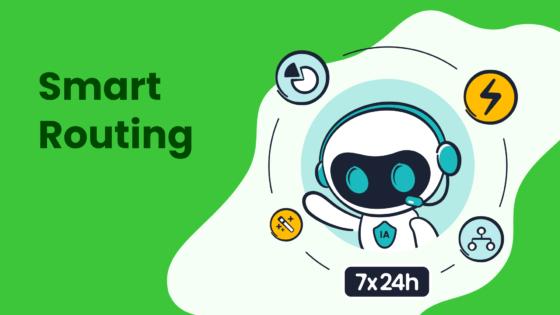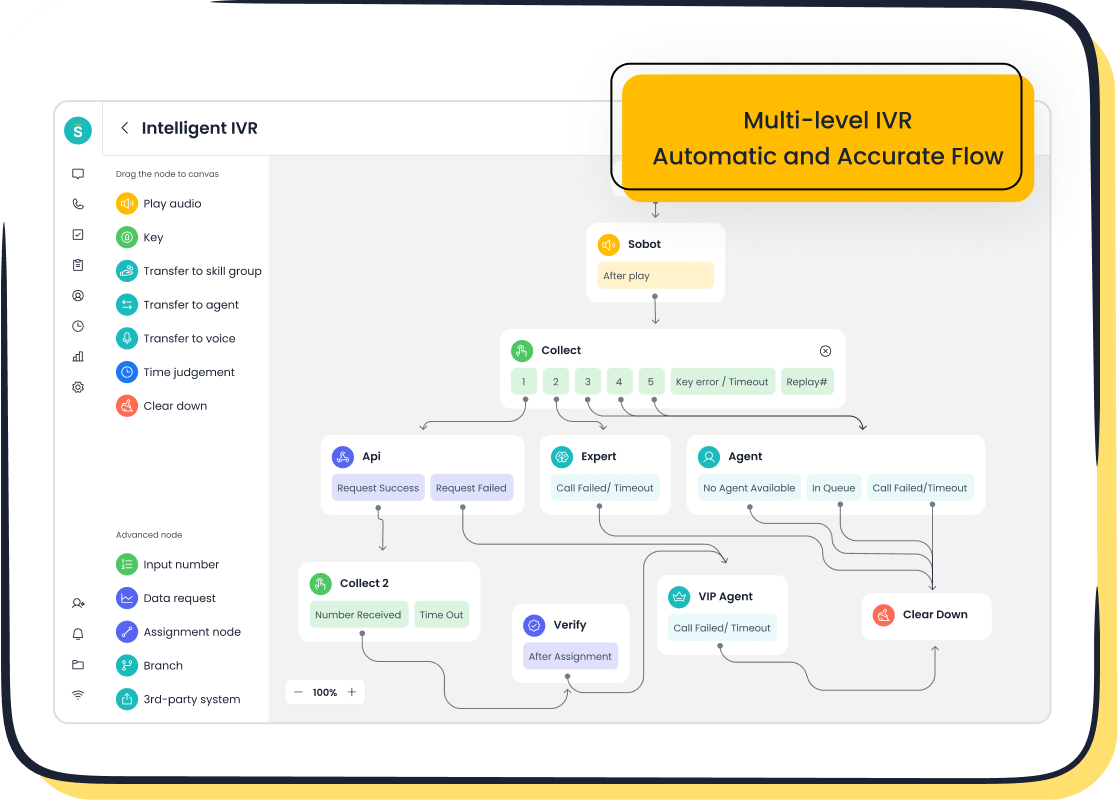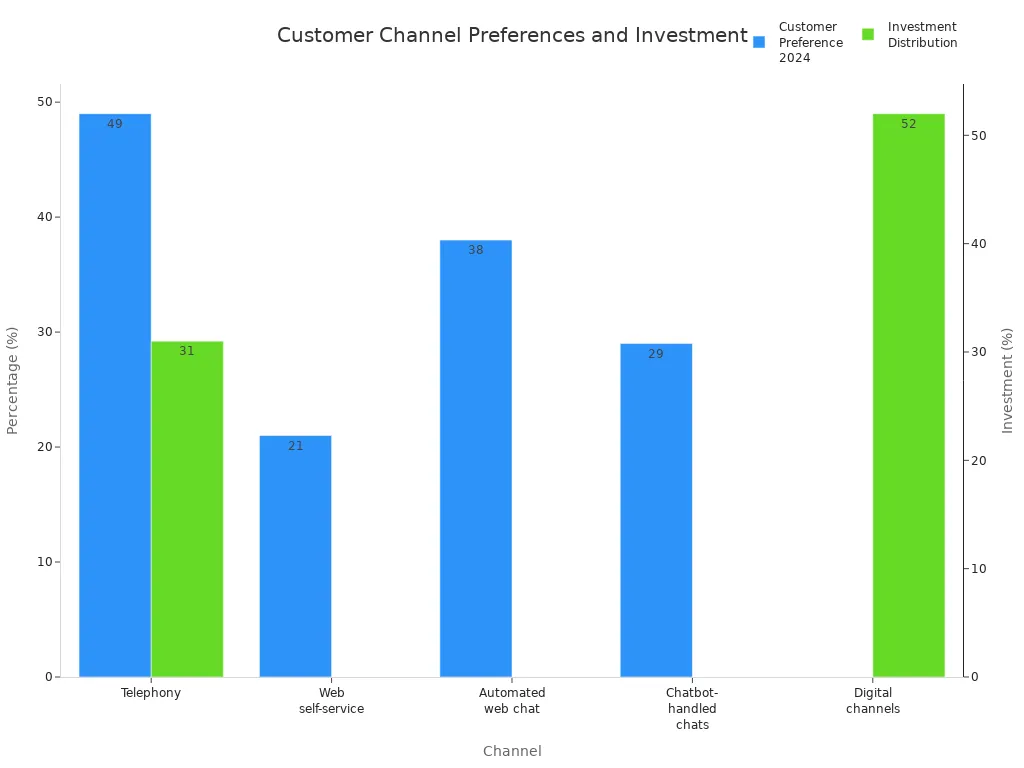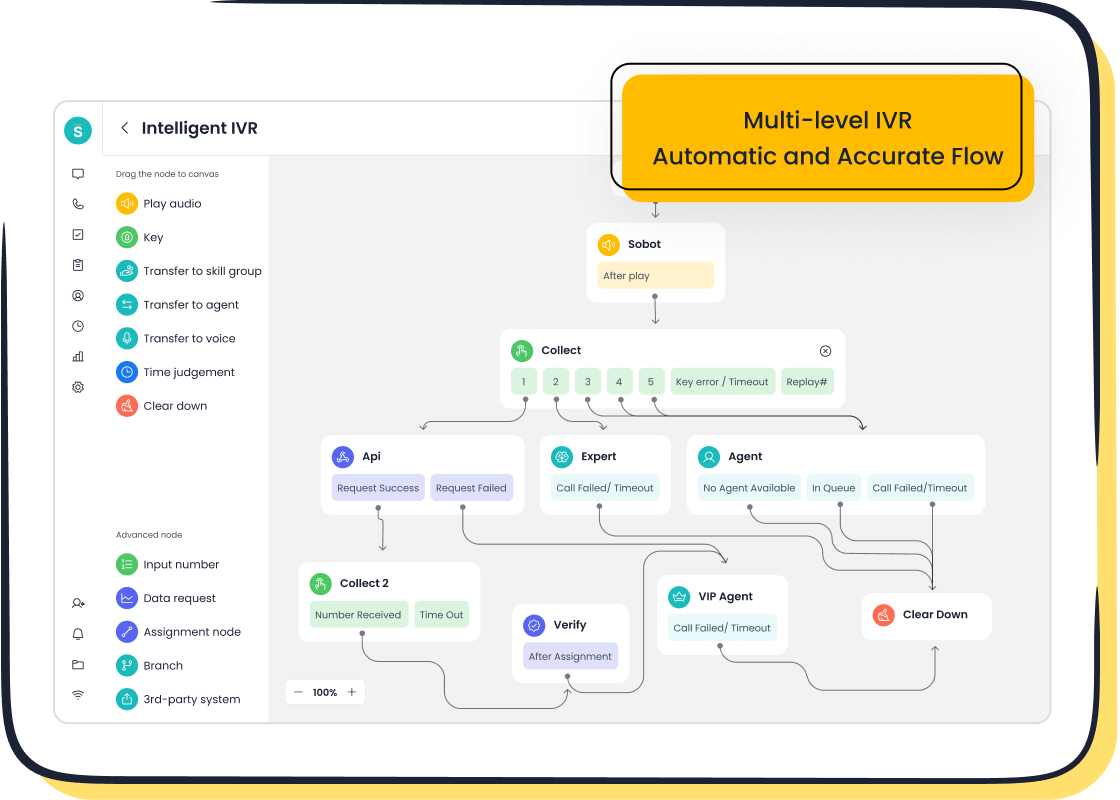Omni Channel Contact Center Best Practices for 2025

In 2025, the best practices for any omni channel contact center focus on delivering a seamless customer experience across every touchpoint. Companies see real results when they use strong strategies and leverage new trends. Sobot stands out with its Sobot AI and Sobot call center, offering unified platforms that enable efficient, personalized experiences. Recent statistics show 71% of companies using digital omnichannel platforms report significant business value, while customer-centric strategies drive growth and reduce costs.
| Statistic Description | Value / Impact | Source |
|---|---|---|
| Contact centers adopting dedicated omnichannel routing tools | 25% | Deloitte Digital |
| Companies using digital omnichannel integration platforms reporting significant business value | 71% | Deloitte Digital |
| Average cost reduction per assisted contact among these companies | 9% drop | Deloitte Digital |
| Companies with strong omnichannel engagement strategies experiencing year-over-year growth | 10% growth in revenue, 10% increase in average order value, 25% increase in close rates | Adobe |
Leading trends include AI-powered platforms, cloud agility, and omnichannel strategies that help organizations boost customer loyalty and agent performance.
Integration in Omni Channel Contact Center

Unified Platform with Sobot
Modern omni channel contact centers rely on unified platforms to manage customer interactions across multiple channels. Sobot’s omnichannel solution stands out by integrating voice, chat, email, social media, and messaging apps into a single, intelligent workspace. This unified approach allows agents to view all customer data and history in one place, which improves response times and reduces errors.
- Sobot uses an API-based architecture to connect different communication systems. This enables real-time data exchange and seamless management of customer interactions.
- The platform’s scalable design and enterprise-grade security ensure it can handle high volumes of interactions securely.
- AI-powered chatbots in Sobot manage up to 80% of routine inquiries, freeing agents to focus on complex issues.
- Predictive analytics and omnichannel messaging provide consistent, personalized experiences across SMS, email, chat, and voice.
- Companies using unified platforms like Sobot have seen a 25% increase in customer response rates and a 30% increase in conversion rates. Retention rates can be up to 2.5 times higher for organizations with robust omnichannel strategies.
Sobot’s integration capabilities also extend to CRM and e-commerce systems, creating a unified customer view. This allows businesses to automate ticket routing, FAQs, and troubleshooting, which reduces manual workload and improves operational efficiency. AI-powered features such as Natural Language Processing and sentiment analysis further enhance the quality of customer interactions.
Sobot leverages generative AI to create smarter, faster, and more meaningful customer engagement. By 2025, 97% of businesses plan to incorporate AI into customer communications, focusing on AI voice assistants and integrated omnichannel strategies.
Real-World Success: Opay’s Transformation
A strong example of seamless integration comes from Opay, a leading financial service platform. Opay faced challenges managing high volumes of customer interactions across social media, email, and voice channels. After implementing Sobot’s omnichannel solution, Opay unified its customer service operations. The results were impressive:
| Metric | Before Sobot | After Sobot | Improvement |
|---|---|---|---|
| Customer Satisfaction Rate | 60% | 90% | +30% |
| Operational Cost Reduction | - | -20% | -20% |
| Conversion Rate | - | +17% | +17% |
Sobot’s platform enabled Opay to manage inquiries efficiently, automate repetitive tasks, and deliver a consistent customer experience. The intelligent IVR system allowed 60% of customers to resolve issues independently, reducing agent workload. The WhatsApp Business integration achieved an 85% message reading rate, boosting marketing outreach. These results show how unified contact center technology can drive measurable business growth and customer satisfaction.
Consistent Experience Across Channels
Delivering a consistent customer experience across all channels is essential for building trust and loyalty. Customers expect the same level of service whether they interact via phone, chat, email, or social media. Sobot’s omnichannel communication tools ensure that every touchpoint reflects the brand’s values and service standards.
- Consistent experiences across apps, websites, and physical stores create predictability, which fosters customer loyalty and strengthens brand reputation.
- Integrated promotion, which coordinates messaging and incentives across digital and physical channels, positively impacts satisfaction and purchase intentions.
- Research shows that 90% of highly satisfied customers are likely to return and recommend the brand, highlighting the financial benefits of consistent customer experience.
- Unified communication strategies and service integration shape positive omnichannel customer experiences.
Sobot’s unified workspace centralizes customer data and streamlines inquiry routing. This ensures that agents have the information they need to provide personalized, accurate responses. Automated ticketing and CRM integration help maintain consistency, even as customers move between channels. Companies that standardize processes and KPIs across locations see improved customer satisfaction and business results.
Maintaining consistency helps prevent negative experiences at one location from damaging the brand as a whole. Psychological research supports that humans seek predictability, so consistent experiences build trust and reinforce brand reliability.
Customer Channel Preferences
Understanding customer channel preferences is key to effective omni channel contact center strategies. Customers want to choose how they interact with businesses, whether by phone, chat, email, or social media. Sobot’s omnichannel solution supports this flexibility, allowing seamless transitions between channels without requiring customers to repeat information.

| Customer Channel Preference Aspect | Statistic / Insight |
|---|---|
| Most preferred channel (2024) | Telephony (49% of US consumers as first choice) |
| Second most popular channel | Web self-service (21%) |
| Telephony preference trend | Increased since 2018, overtaking web self-service |
| Telephony preference for complex enquiries | Rose from 28% in 2018 to 47% in 2024 |
| Business view on best channel for interactions | Telephony preferred by majority (80% for high emotion, 62% for high urgency, 74% for complexity) |
| Investment distribution | 52% in digital channels vs. 31% in telephony despite telephony handling over 70% of interactions |
| Digital channel growth | Automated web chat use increased from 15% to 38% since 2019; chatbot-handled chats rose from 20% to 29% |
| Pandemic effect | Shift back to telephony due to customer confidence |
- 73% of consumers prefer completing purchases through multiple channels, highlighting the need for unified experiences.
- Personalized experiences are highly valued, with around 90% of consumers finding them appealing.
- Omnichannel approaches improve customer satisfaction, loyalty, and retention by meeting diverse channel preferences.
- Empathy and human-like service across channels are critical, with 62% of consumers wanting brands to show more care.
Sobot’s contact center technology empowers businesses to meet these expectations. The platform supports global telephony, live chat, email, and messaging apps, ensuring customers can connect through their preferred methods. AI-powered automation resolves tickets 52% faster and reduces service costs by 30%. Organizations benefit from 24/7 support availability and seamless customer interactions across platforms.
Sobot’s omnichannel solution delivers measurable benefits, including productivity gains of up to 400% and significant cost reductions. These outcomes illustrate the value of integrating advanced contact center technology to support diverse customer needs.
AI and Automation Trends
Artificial intelligence is transforming the contact center technology landscape. In 2025, the contact center industry trends show a strong shift toward automation, real-time analytics, and smarter customer engagement. Companies now rely on AI to improve efficiency, reduce costs, and deliver better customer experiences. Sobot leads this transformation with advanced AI-powered solutions, including its Voicebot and intelligent IVR, which help businesses stay ahead of the curve.
AI-Powered Agent Assist
AI-powered agent assist tools have become essential in modern contact center technology. These tools work alongside human agents, providing real-time support and actionable insights during customer interactions. The latest advancements in AI agent assist include:
- Integration with CRM and communication platforms to pull relevant customer data instantly.
- Real-time analysis of conversations using speech and text analytics to understand context and intent.
- Natural Language Processing (NLP) that evaluates sentiment, tone, and intent, offering agents the best responses.
- Automated suggestions for knowledge articles, upsell opportunities, and compliance alerts.
- Automation of routine tasks such as call summarization and data entry, speeding up workflows.
- Machine learning models that learn from every interaction, improving accuracy over time.
| Advancement/Feature | Description | Impact/Benefit |
|---|---|---|
| Advanced Generative AI | Creates human-like, personalized responses | Improves customer interaction quality |
| Autonomous AI Agents | Handle complex queries independently | Reduces human intervention, speeds up resolution |
| Emotion AI | Analyzes sentiment and tone in real time | Increases customer satisfaction |
| Integration with Business Systems | Connects with CRM and enterprise platforms for instant data retrieval | Streamlines workflows, reduces agent effort |
| Self-Learning AI Models | Continuously improve from interactions | Adapts to changing customer needs |
| Efficiency Gains | Automates responses and decision support | Increases agent efficiency by up to 80% |
| Cost Reduction | Reduces call escalations and staffing needs | Cuts operational costs by 20-40% |
| Customer Satisfaction Improvement | Faster, accurate responses | Increases CSAT by 10-25% |
| Faster Training & Onboarding | Provides real-time guidance | Reduces training time by 50% |
| Better Resolution Rates | Delivers context-aware solutions | Improves First Call Resolution by up to 35% |
AI-powered agent assist in contact center technology brings many benefits. Agents receive real-time prompts, knowledge suggestions, and sentiment analysis, which help them respond quickly and accurately. These tools reduce agent burnout by automating repetitive tasks, allowing agents to focus on complex issues. Companies see improved agent productivity, faster onboarding, and higher customer satisfaction. For example, real-world implementations in telecom and healthcare have shown reduced handling times and better service quality.
Sobot’s AI-powered workspace integrates these features, supporting agents with real-time insights and automating routine tasks. This approach ensures consistent service quality and helps businesses adapt to changing customer needs. As a result, organizations using Sobot’s contact center technology report higher efficiency and better customer outcomes.
AI in the contact center is not just about automation. It is about empowering agents to deliver empathetic, personalized service at scale.
Chatbots and Self-Service
Chatbots and self-service options have become vital components of contact center technology. Customers expect quick answers and the ability to solve problems on their own. AI-driven chatbots provide conversational AI support, handling up to 80% of routine questions without human intervention. These chatbots use natural language processing to understand customer requests and deliver accurate responses.
Self-service options, such as IVR, knowledge bases, and FAQs, allow customers to resolve issues independently. This reduces wait times and operational costs. For example, a telecommunications company implemented an AI chatbot that enabled customers to manage data usage and pay bills without speaking to an agent. This change led to lower contact volumes and allowed agents to focus on complex problems.
AI-powered chatbots offer 24/7 support across time zones, ensuring consistent service. They also assist agents by providing real-time guidance, which speeds up problem resolution and maintains high service quality. Companies that use self-service tools see improved customer satisfaction and increased productivity. Stanley Black & Decker, for instance, saw customer satisfaction rise from 85% to 90% after deploying AI chatbots. Statistics show that 61% of users resolve issues with conversational AI, compared to only 35% with traditional chat.
Sobot’s omnichannel solution includes AI-powered chatbots and self-service portals. These tools integrate with backend systems, providing seamless support across channels. Customers can access help through voice, chat, email, or messaging apps, choosing the method that suits them best. Sobot’s self-service options reduce repetitive queries, lower costs, and improve both customer experience and contact center productivity.
Self-service is not just a convenience. It is a necessity for modern contact center technology, driving efficiency and satisfaction for both customers and agents.
Workflow Automation with Sobot Voice/Call Center
Workflow automation stands at the heart of modern contact center technology. Automated workflows streamline operations, reduce response times, and ensure smooth handoffs between agents and channels. In the contact center industry trends for 2025, automation is a key driver of operational efficiency.
Studies show that workflow automation can reduce first response times by 22% and increase resolution efficiency by 18%. Companies like Lulu and Georgia have achieved these improvements by automating repetitive workflows and managing escalations more effectively. Automation handles tasks such as sending initial replies, routing tickets, and managing escalations, which reduces manual workload and prevents multiple contacts for the same issue.
| Evidence Aspect | Details |
|---|---|
| Quantitative Impact | 22% reduction in first response times; 18% increase in resolution efficiency |
| Workflow Automation Functions | Automates repetitive workflows, manages escalations, adapts to ticket volume spikes |
| Operational Benefits | Reduces handling times and agent workload, ensures smooth escalations and handoffs |
| Support Example | Lulu and Georgia companies leveraging AI-powered automation achieving these improvements |

Sobot’s Voice/Call Center solution leverages AI and automation to optimize every step of the customer journey. Intelligent IVR routes calls to the right agent or department, reducing wait times and improving first-contact resolution. AI-powered Voicebot interacts with customers, recognizes intent, and provides instant answers or escalates complex issues to human agents. Real-time data analysis helps managers optimize staffing and workflows based on call volume patterns.
Sobot’s platform centralizes queries from multiple channels, enabling faster responses and better coordination. Automation allows agents to focus on high-value interactions, while routine tasks are handled efficiently in the background. This approach not only improves response quality and speed but also reduces operational costs.
Companies that embrace workflow automation in contact center technology gain a competitive edge. They deliver faster, more reliable service and adapt quickly to changing customer demands.
Industry Trends for 2025: The Future of AI in Contact Centers
The contact center industry trends for 2025 highlight several important shifts. Natural Language Processing continues to advance, enabling chatbots, voice assistants, and sentiment analysis to improve efficiency and customer satisfaction. Generative AI tools personalize responses based on customer context, adding empathy to every interaction. Agentic AI, with autonomous reasoning capabilities, is transforming enterprise automation by handling complex operations beyond traditional automation.
Robotic Process Automation is evolving into intelligent, end-to-end automation systems. These systems reduce manual intervention and increase accuracy, especially in sectors like finance and healthcare. Generative AI is now used for content creation, personalized follow-ups, and agent assistance. Experts predict that 80% of customer service organizations will adopt generative AI by 2025.
Recent surveys show that 98% of contact centers have already adopted AI, and 83% of leaders believe AI will enable 24/7 omnichannel customer support. However, challenges remain. Only 36% of contact centers have a true omnichannel setup, and 32% of leaders cite agent distrust in AI as a barrier. Ethical concerns, data privacy, and regulatory issues also limit adoption for 71% of leaders.
Key trends shaping the future of AI in contact centers include:
- Autonomous AI agents that understand customer intent and context, improving first-contact resolution.
- Assistive AI agents that summarize conversations and generate case summaries, boosting agent productivity.
- AI-enhanced knowledge management, integrating multiple sources for better self-service and accuracy.
- Omni-channel routing that directs inquiries to the best agent based on skills and availability.
- Automated service workflows that reduce manual tasks and allow agents to focus on complex interactions.
Sobot’s commitment to innovation ensures that its contact center technology stays ahead of these trends. The platform’s AI-driven features, including Voicebot, intelligent IVR, and workflow automation, help businesses deliver proactive, personalized, and always-on customer engagement. Sobot’s secure, scalable solutions support organizations as they navigate the evolving landscape of artificial intelligence in customer service.
Artificial intelligence is not just a trend. It is the foundation of the next generation of contact center technology, enabling businesses to deliver exceptional customer experiences at scale.
Omnichannel Customer Engagement
Personalization with Customer Intelligence
Personalization stands at the core of effective omnichannel customer engagement. Companies use unified customer data to deliver personalized experiences that drive acquisition and loyalty. Sobot’s unified workspace collects and analyzes customer information from every channel. This approach enables brands to segment audiences, predict needs, and tailor content for each stage of the customer journey. AI-driven automation delivers timely, relevant messages, increasing engagement and conversions. For example, Petco increased won-back customers by 15% through AI-powered campaigns, while Nike saw over 110% revenue growth from one-to-one engagement. Brands that integrate data across channels report a 9.5% rise in annual revenue and a 7.5% drop in cost per contact. Personalization at scale, powered by unified data, breaks down silos and creates consistent, personalized customer experiences that foster loyalty.
Proactive Service and Analytics
Proactive service strategies transform customer experience from reactive to anticipatory. Sobot’s analytics tools track key metrics such as response times, call abandonment, agent performance, and first contact resolution. The table below shows how these metrics impact customer retention:
| Metric | Description | Impact on Retention |
|---|---|---|
| Response Times | Speed of agent replies | Faster responses build trust |
| Call Abandonment Rates | Customers who hang up before reaching agents | Lower rates improve satisfaction |
| Agent Performance | Knowledge and efficiency | High performance fosters loyalty |
| Customer Effort Score | Ease of issue resolution | Lower effort increases satisfaction |
| First Contact Resolution | Issues solved in first interaction | Higher rates boost retention |
AI-driven tools, such as real-time agent assistance and predictive analytics, help agents anticipate needs and resolve issues before they escalate. Companies like Copa Airlines and Anglian Water have reduced support case volume and costs through proactive service. Sobot’s analytics empower teams to identify pain points, optimize workflows, and deliver consistent, high-quality engagement.
Multichannel Support with Sobot
Sobot’s multichannel support tools enable seamless omnichannel customer engagement. The platform supports web chat, mobile apps, social media, and messaging platforms, ensuring customers can connect through their preferred channels. Intelligent routing directs inquiries to the right agent, while sentiment analysis prioritizes urgent cases. Real-time analytics provide insights into customer behavior and team performance. Sobot’s knowledge base and self-service portals empower customers to resolve issues independently, reducing support workload and improving satisfaction. Integration with CRM systems creates a unified customer service experience. Opay’s adoption of Sobot led to a 30% increase in customer satisfaction and a 17% rise in conversion rates, demonstrating the value of unified, data-driven engagement strategies.
Agent Empowerment and Well-being

Training and Upskilling
Contact center agents need strong training to deliver excellent customer experiences. Recent studies show that companies gain about $3 for every $1 spent on agent training. Effective programs focus on communication, problem-solving, and empathy. Sobot’s unified workspace supports these efforts by providing access to knowledge bases and AI-powered coaching tools. The most effective training methods include:
- Immersive VR simulations for real-world practice.
- Peer mentoring to help new agents learn quickly.
- Comprehensive product training for deep understanding.
- KSAC profiles to match training with job needs.
- Interactive sessions using games and videos.
- Continuous feedback through surveys and safe channels.
- Data-driven customization based on common issues.
- Talk-and-type multitasking exercises.
- Conversation analytics and AI coaching for personalized improvement.
- Clear career path visualization to motivate agents.
These strategies help agents build confidence, reduce stress, and improve customer satisfaction.
Support for Remote and Hybrid Agents
Remote and hybrid work models have become essential in modern contact centers. Research from Stanford University found a 13% productivity increase among remote agents, while another study showed a 50% drop in attrition. Sobot’s cloud-based platform enables agents to work from anywhere, offering secure access to all communication channels and customer data. Features like agent self-scheduling and real-time dashboards help teams stay connected and productive. Flexible work options also improve work-life balance, which leads to higher engagement and lower turnover.
Engagement and Burnout Prevention
Preventing burnout and boosting engagement are top priorities for contact center leaders. Early recognition of burnout signs, such as emotional exhaustion and absenteeism, allows for timely intervention. Sobot’s AI-driven analytics monitor workloads and agent well-being, supporting smart scheduling and regular breaks. Proven strategies include:
- Supportive training and coaching on stress management.
- Empowering agents with modern AI tools to reduce repetitive tasks.
- Flexible shifts and remote work to improve balance.
- Recognition programs and gamified training to increase motivation.
- Frequent feedback and open communication to foster trust.
A Gallup study found that employees who feel supported by managers are 70% less likely to experience burnout. Sobot’s unified workspace and workload management tools help organizations maintain high engagement and deliver consistent, high-quality service.
Security and Compliance in Omnichannel
Data Privacy and Protection
Omnichannel contact centers handle large volumes of sensitive customer data across many channels. This creates more points of vulnerability. In 2025, organizations must adopt strong data privacy and protection measures to keep information safe. Leading platforms like Sobot use advanced encryption for all data transfers and maintain strict access controls. Sobot’s system stability reaches 99.99% uptime, ensuring reliable service and continuous protection for every customer interaction.
Many U.S. states now enforce privacy laws that require companies to honor data access, deletion, and consent requests. For example, California, Iowa, and Delaware have laws that demand clear privacy policies and quick responses to opt-out requests. Fines for violations can reach $7,500 or more. Companies must update privacy policies, train staff, and use technology to automate compliance. Regular security assessments and staff training help maintain robust protection across all touchpoints.
Regulatory Trends for 2025
Regulatory trends in 2025 show stricter rules for data privacy and security worldwide. Laws like GDPR and CCPA require companies to minimize data collection and document customer consent. New AI regulations, such as the EU AI Act, demand transparency when customers interact with AI systems. Companies must explain how AI makes decisions and ensure ethical use.
Omnichannel contact centers face challenges because each channel—phone, email, chat, or social media—may have different compliance needs. Distributed workforces add complexity, making real-time oversight tools essential. Sobot addresses these needs with encrypted data transfer, secure access controls, and compliance with global standards like GDPR and HIPAA. Regular audits and proactive compliance strategies help organizations stay ahead of changing requirements.
Building Customer Trust
Strong compliance measures build trust with customers. When companies protect data with encryption and clear privacy practices, customers feel safe sharing information. Leadership commitment and a culture of compliance show responsibility and integrity. Sobot’s secure platform, with 99.99% uptime and regular audits, reassures customers that their data is safe.
Non-compliance can damage a company’s reputation and lead to loss of customer loyalty. Regular staff training and transparent communication about data use help maintain trust. Customers value control over their data and want to know how it is used. By prioritizing security and compliance, companies improve the overall customer experience and strengthen long-term relationships.
Contact Center Trends and Agility
Cloud Migration and Scalability
Cloud-based contact center solutions have become the foundation for modern customer service. Companies now migrate from on-premises systems to cloud platforms to gain agility, scalability, and continuous innovation. The latest contact center trends show that cloud migration enables rapid adaptation to changing customer expectations and operational needs. According to the 2024 Gartner Magic Quadrant, businesses choose cloud-based contact center platforms for their ability to scale agent capacity quickly and support remote work. These platforms also integrate AI and automation, which improve efficiency and customer satisfaction. Sobot’s cloud-based contact center leverages a global network with regional data centers, ensuring secure, reliable performance worldwide. The platform’s AI-driven features, such as Voicebot and real-time analytics, help organizations deliver 24/7 support and optimize operations. Companies that plan cloud migration should focus on phased implementation, employee training, and regular security audits to maximize benefits and maintain compliance.
Flexible Staffing and Remote Work
Flexible staffing models are a key trend in contact center operations. Modern contact centers use part-time, split shifts, and on-demand staffing pools to handle fluctuating demand. Remote work has become popular, with 80% of customer service employees preferring hybrid or remote models. This approach allows companies to access a wider talent pool and improve retention. Flexible contracts and workforce management tools enable rapid schedule adjustments, helping managers control costs and maintain service levels. Sobot’s cloud-based contact center supports remote agents by providing secure access to all communication channels and customer data. Real-time dashboards and mobile apps allow agents to update availability and managers to adjust staffing quickly. These practices increase operational agility and ensure the right number of agents are available at all times.
Adapting to Market Changes
Contact center trends highlight the importance of adapting to market changes for future-proofing operations. Companies must embrace AI, automation, cloud infrastructure, and omnichannel communication to keep up with evolving customer needs. Sobot’s omnichannel AI integrates chat, email, voice, and social platforms, creating seamless customer experiences. Data analytics and predictive machine learning help forecast customer behavior and address needs proactively. Cloud-based contact center solutions enable on-demand scalability, supporting seasonal spikes and remote workforce management. Organizations that adapt quickly maintain high customer satisfaction and operational efficiency. Without agility, contact centers risk falling behind in a competitive market.
Sobot’s global network and advanced AI features empower businesses to respond swiftly to new trends, ensuring long-term success in a dynamic environment.
Omni channel contact center best practices in 2025 focus on seamless integration, advanced AI, and customer engagement. Sobot’s platform delivers proven results—OPPO reached 93% CSAT, Agilent cut costs by 25%, and Samsung achieved 97% satisfaction. Companies benefit from real-time analytics, multilingual support, and flexible integration with platforms like Salesforce and Shopify. Leaders should review their omni channel contact center strategies, set clear goals, and explore Sobot’s solutions for future growth.
Discover how Sobot can transform your omni channel contact center at sobot.io.
FAQ
What is an omni channel contact center?
An omni channel contact center connects all customer communication channels—phone, chat, email, and social media—into one platform. This approach gives agents a complete view of each customer’s journey. Companies like Sobot help businesses deliver seamless, consistent service across every channel.
How does Sobot improve omni channel contact center efficiency?
Sobot’s unified workspace integrates voice, chat, email, and messaging apps. Agents access all customer data in one place. This reduces response times and errors. For example, Opay increased customer satisfaction by 30% after adopting Sobot’s omni channel contact center solution.
Why is AI important in an omni channel contact center?
AI automates routine tasks, analyzes customer sentiment, and provides real-time agent support. Sobot’s AI-powered Voicebot and chatbots handle up to 80% of common inquiries. This allows agents to focus on complex issues and improves overall customer satisfaction in the omni channel contact center.
How does an omni channel contact center support remote work?
Cloud-based omni channel contact center platforms, like Sobot, let agents work from anywhere. Agents access secure customer data and communication tools online. This flexibility increases productivity and lowers turnover. Studies show remote agents are 13% more productive than in-office staff (Stanford).
What security features does Sobot offer for omni channel contact centers?
Sobot provides encrypted data transfer, strict access controls, and 99.99% system uptime. The platform complies with global standards like GDPR and HIPAA. These features protect customer information and build trust in every omni channel contact center deployment.
See Also
How To Successfully Deploy Omnichannel Contact Center Solutions
Comprehensive Overview Of Omnichannel Software For Call Centers
Best Contact Center Technologies Evaluated For The Year 2024
